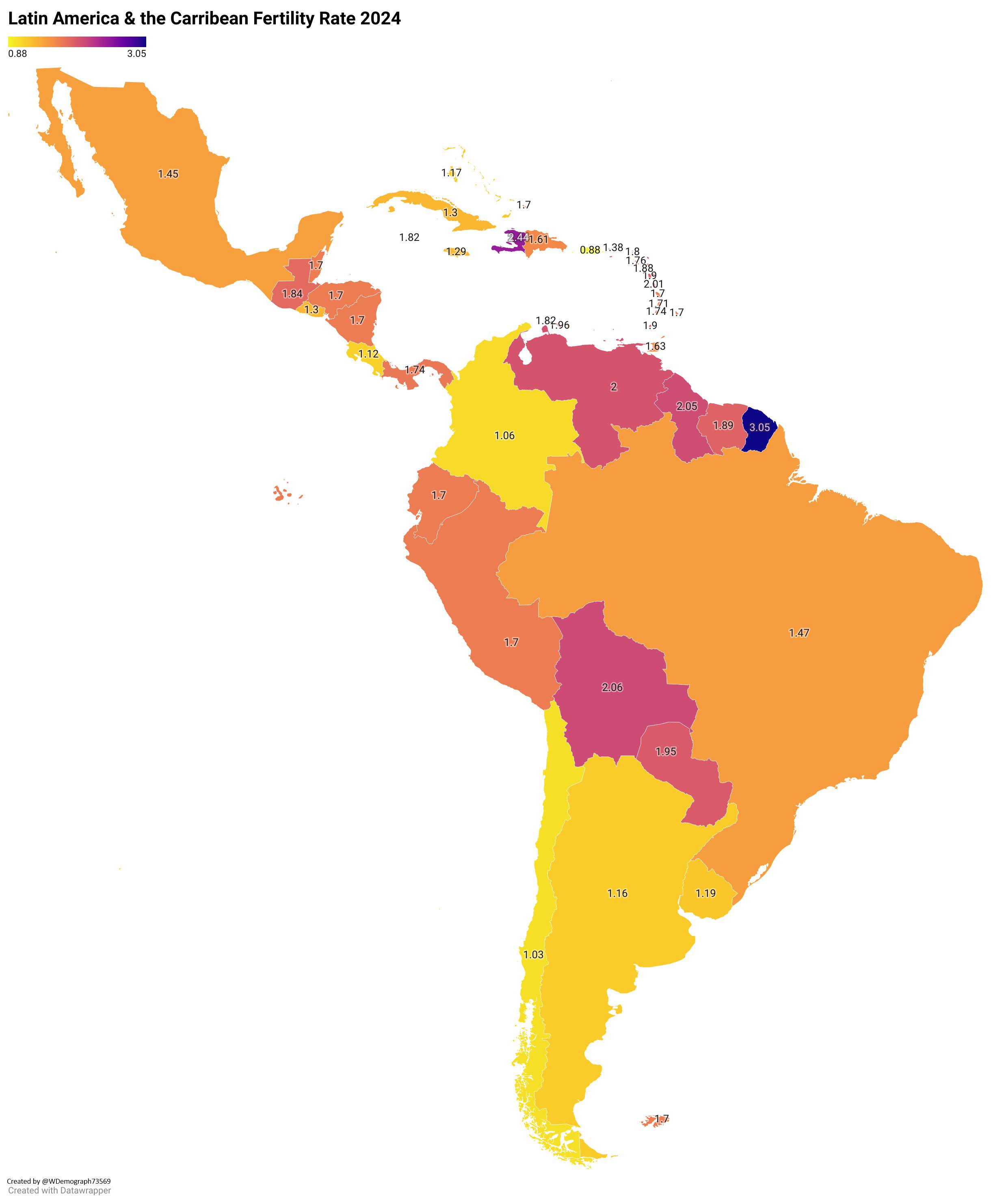Fertility Rate Map of Latin America & The Caribbean 2024


Marcus Rodriguez
Historical Geography Expert
Marcus Rodriguez specializes in historical cartography and geographic data analysis. With a background in both history and geography, he brings unique...
Geographic Analysis
What This Map Shows
The "Fertility Rate Map of Latin America & The Caribbean 2024" provides a clear visualization of the current fertility rates across different countries in the region. Fertility rate, often measured as the number of live births per woman, is a crucial demographic indicator that reflects population growth, societal trends, and public health. This map highlights the varying fertility rates, allowing us to understand how each country is faring in terms of population growth and family planning.
Deep Dive into Fertility Rates
Fertility rates are influenced by a multitude of factors such as economic conditions, cultural norms, access to healthcare, and education levels, especially among women. In Latin America and the Caribbean, these rates have been on a declining trend over the past few decades. For instance, in the early 2000s, many countries in this region had significantly higher fertility rates, often exceeding five children per woman. However, as we approach 2024, many nations are seeing their rates drop below the replacement level of 2.1 births per woman, which is needed to maintain a stable population.
Interestingly, countries like Brazil and Argentina have seen substantial declines in fertility rates, now averaging around 1.7 and 2.3 births per woman, respectively. This decline can be attributed to increased access to contraception, higher educational attainment for women, and shifting societal norms surrounding family size. In contrast, nations such as Guatemala and Honduras still exhibit higher fertility rates, with averages around 3.5 to 4.0 births per woman. These higher rates can often be linked to limited access to education and healthcare services, along with cultural preferences for larger families.
The influence of urbanization cannot be overstated either. As more people move from rural to urban areas, family structures and economic considerations change dramatically. Urban settings tend to offer greater access to education and employment opportunities for women, leading to more informed choices about family planning. The impact of education on fertility is profound—women with higher education levels are more likely to delay childbirth and have fewer children.
Moreover, the COVID-19 pandemic has introduced additional complexities to fertility trends. Initially, many countries saw a decline in birth rates during the pandemic due to economic uncertainty and disruptions in healthcare. However, as countries recover and begin to stabilize, some experts predict a potential baby boom in the coming years as families who delayed childbirth during the pandemic start to expand their families.
Regional Analysis
When examining the map, it's evident that the Caribbean region presents a tapestry of fertility rates. For instance, countries like Cuba and Barbados boast low fertility rates of 1.6 and 1.5 respectively, reflecting their advanced healthcare systems and high levels of female education. Conversely, nations like Haiti still struggle with higher fertility rates, hovering around 3.2 births per woman, largely due to socio-economic challenges and limited access to reproductive health services.
In South America, a noticeable gradient emerges. The southern cone, including Chile and Uruguay, showcases some of the lowest fertility rates in the region, with averages around 1.6 and 1.8 respectively. These declines are indicative of strong female empowerment and robust family planning programs. On the other hand, Andean countries such as Bolivia display higher fertility rates, approximately 2.8, which can be linked to both cultural values and economic factors that favor larger families.
Significance and Impact
Understanding fertility rates is crucial not just for demographic insights but also for planning resources and services. A declining fertility rate can lead to an aging population, presenting challenges for healthcare systems and pensions. Conversely, countries with higher fertility rates may face the need for increased investment in education, healthcare, and job creation to support a growing population.
The implications of these trends extend beyond numbers—they influence economic development, social policies, and even environmental sustainability. For instance, a young, rapidly growing population may place strain on natural resources, while an aging population may result in labor shortages and increased healthcare costs. Thus, as we look towards the future, monitoring fertility rates will be essential for governments and organizations aiming to implement effective policies that align with demographic realities.
So, the next time you glance at the fertility rate map of Latin America and the Caribbean, think about the broader implications of those numbers. How do they reflect the intricate interplay of culture, economy, and health? The answers may shape the future of the region in profound ways.
Visualization Details
- Published
- August 14, 2025
- Views
- 294
Comments
Loading comments...